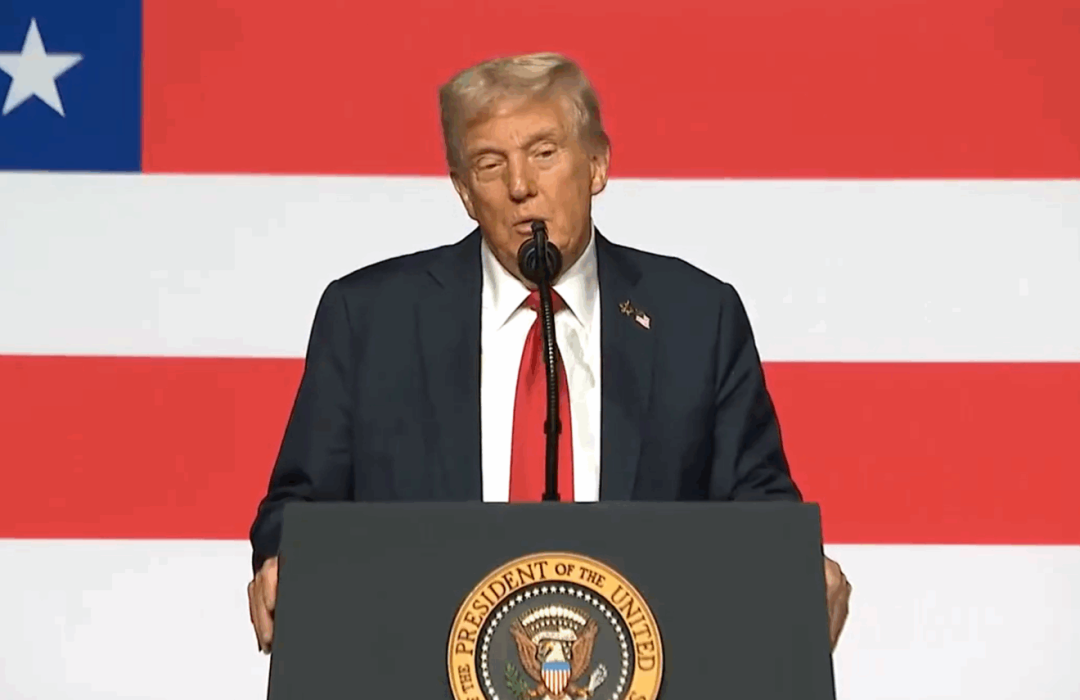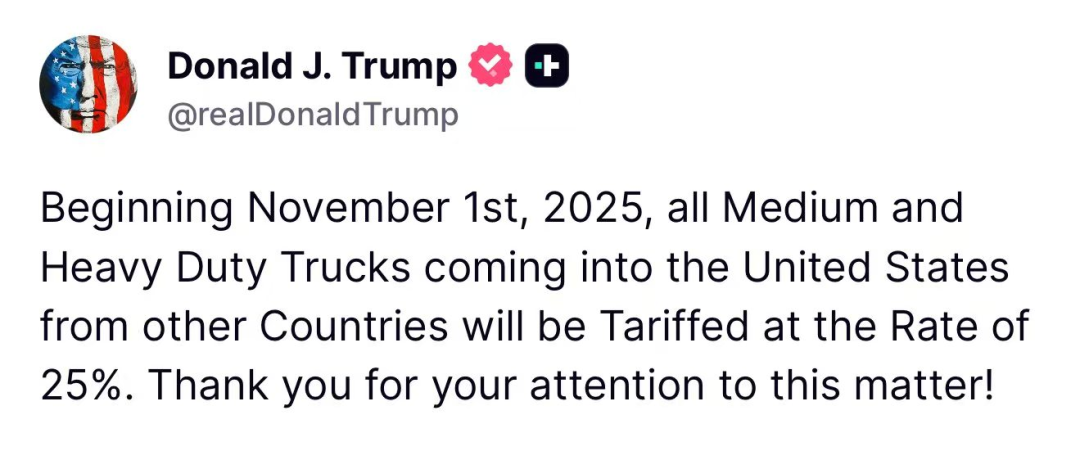Trump Announces 25% Tariff On All Countries Effective November 1

On October 7, 2025, U.S. President Trump officially announced on the Truth Social platform that, starting from November 1, 2025, the United States will impose a 25% tariff on all imported medium- and heavy-duty trucks.

Trump Truth Social screenshot
This decision was initially scheduled to take effect on October 1 but has been postponed to November 1. This policy is the latest extension of the Trump administration's trade protectionism measures, aimed at protecting domestic manufacturing through tariff barriers.
Trump's announcement was not sudden, but rather based on a tariff investigation initiated by the U.S. Department of Commerce in April of this year. The investigation, conducted under Section 232 of the Trade Expansion Act, assesses the potential threat that imported trucks pose to U.S. national security. This provision allows the president to impose tariffs on imported products deemed "essential to national security," which has previously been used to levy tariffs on automobiles, steel, and aluminum products.
The trucking industry is crucial to the U.S. economy: statistics show that the American trucking industry is responsible for about 73% of domestic freight transportation, with a total value of over $10 trillion. Imported trucks (especially medium and heavy-duty models) are seen as a threat to domestic employment and supply chain security, thus the investigation results support the imposition of tariffs. Trump hinted at this move in a social media post as early as last month, emphasizing the need to "protect American workers and manufacturers."
Scope and Implementation
⚠️ Applicable Objects: Medium and heavy trucks refer to commercial vehicles with a load capacity of over 6 tons, including freight trucks, engineering trucks, etc. The tariffs apply to all imported vehicles, regardless of the country, but if the vehicle meets USMCA rules (such as at least 64% regional value content, gradually increasing to 70%; 75% North American content for key components like engines, axles, and transmissions; 70% domestic procurement for steel and aluminum), it may be exempted from or have a reduced tax rate.
⚠️ Effective date: November 1, 2025. Importers have approximately 3 weeks to adjust their supply chains.
⚠️ Tax rate: The unified tax rate for all countries is 25%, higher than the previous 10-25% tariffs on some vehicles.
⚠️ Exemptions and Exceptions: USMCA compliant vehicles may be partially exempt; there is currently no clear guidance on used trucks or specific purpose vehicles (such as military).
The most affected is Mexico's exports: in 2024, Mexico will export 159,000 heavy trucks, 95.5% of which will be destined for the United States. Companies involved include Freightliner, Kenworth, Navistar, Hino, International, DINA, MAN SE, Mercedes-Benz, Isuzu, Scania, Shacman Trucks, Foton, Cummins, Detroit Diesel, Volkswagen Buses, among others. Exports from countries like Canada and China will also be impacted, especially the market share of Chinese brands like Foton and Shacman in the United States.
China is not a direct source of imports for medium and heavy trucks to the United States. However, many Chinese automotive companies have set up factories or re-export through Mexico, indirectly exporting their products to the United States via Mexico.
According to data from the U.S. Department of Commerce, the total import value of medium and heavy trucks into the United States in 2024 is approximately $16 billion, with exports from China accounting for only about 0.26%, valued at $42.1 million (far below Mexico's $15.45 billion and Canada's $4.24 billion). Major export products include commercial trucks from brands such as Foton and Shacman, as well as some electric heavy truck components from BYD.
The Trump administration has made it clear that the purpose of this tariff is to:
Supporting American truck manufacturers: Domestic companies such as PACCAR (the parent company of Peterbilt and Kenworth brands) and Ford will gain a competitive advantage. After the increase in imported truck prices, domestic products become more attractive, helping to stimulate domestic production and employment.
📌 Reduce trade deficit: The United States imports a large number of medium and heavy trucks every year, primarily from Mexico and Canada, which exacerbates trade imbalance. Tariffs are expected to shift some imports towards domestic production or production in compliance with the United States-Mexico-Canada Agreement (USMCA).
📌 National Security Consideration: The investigation suggests that excessive reliance on imported trucks may threaten U.S. logistics and defense transportation capabilities in the event of supply chain disruptions, such as geopolitical conflicts.
【Copyright and Disclaimer】The above information is collected and organized by PlastMatch. The copyright belongs to the original author. This article is reprinted for the purpose of providing more information, and it does not imply that PlastMatch endorses the views expressed in the article or guarantees its accuracy. If there are any errors in the source attribution or if your legitimate rights have been infringed, please contact us, and we will promptly correct or remove the content. If other media, websites, or individuals use the aforementioned content, they must clearly indicate the original source and origin of the work and assume legal responsibility on their own.
Most Popular
-

BASF Signs Another Giant: Covestro Already Set Up, Just Missing Wanhua Chemical?
-

DuPont plans to sell Nomex and Kevlar brands for $2 billion! Covestro Declares Force Majeure on TDI / oTDA-based / Polyether Polyol; GAC Group Enters UK Market
-

Clariant Unveils Cost-Cutting Plan Details, Plans to Shut Down Multiple Plants
-

ExxonMobil Plans to Close UK Ethylene Plant; GPI's Revenue & Profit Both Decline! Haitian's Serbia Base Enters Mass Production
-

Ministry Of Commerce Releases Implementation Opinions On Green Trade, Focusing On Import And Export Of Biodegradable Materials And Other Products






